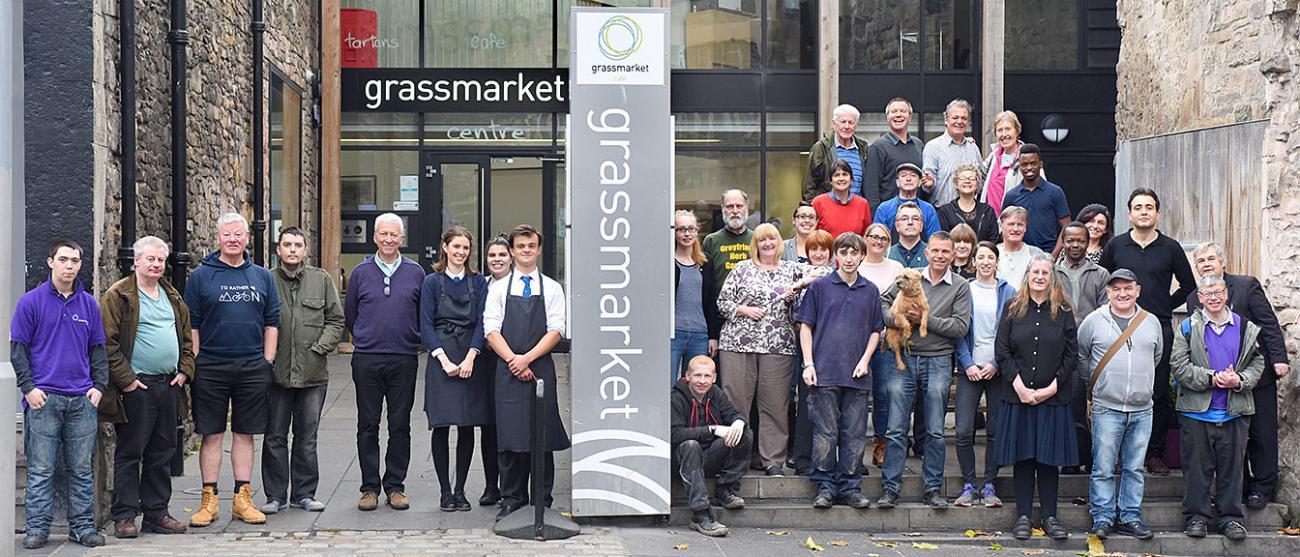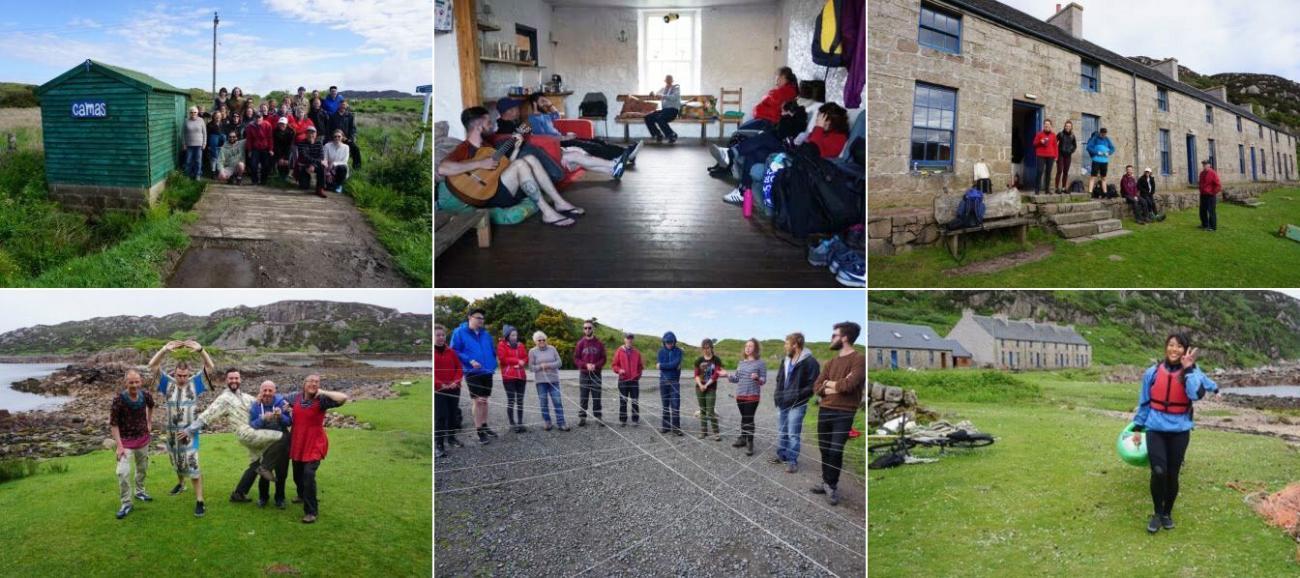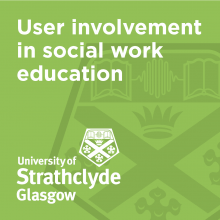This is one of seven stories, showcasing what service user and carer (SUAC) involvement in social work education looks like, what makes it work and what benefits it brings. It has a significant role to play in shaping the next generation of practitioners.
SUAC involvement in social work education has been mandatory for 15 years now, so there is a lot of learning to share with others who can learn from this - transferrable to educators and practitioners working across public services, and relevant to policy-makers committed to mainstreaming person-centred – or person-led – approaches based on real partnership working between those who use and those who deliver services.
Background
This is a piece of reflection and research, informed by interviews with fellow students, academic staff and agency partners, which has been written by a group of six undergraduate and postgraduate social work students from the University of Edinburgh. The students were keen to write the piece in order to share what they and other students have learned from the partner project and to apply some of the research and theory they have been reading to an important area of social work pedagogy and practice.
The partnership between the Grassmarket Community Project and the University of Edinburgh, which will be described in this piece, was set up by Ruth Forbes, Senior Teaching Fellow, and Dr Autumn Roesch-Marsh, Lecturer in Social Work, and Jonny Kinross, Chief Executive of the Grassmarket Project. At the time Autumn was looking at how the social work programme at the University of Edinburgh could more meaningfully involve service users and carers in teaching and she had proposed the idea to colleagues that each course should have its own expert advisors and identified participants which included service users and carers. Autumn ageed to pilot this new approach with her course Social Work in the Community. Autumn initially approached Jonny to carry out a focus group on the topic of Community Social Work with service users at the Grassmarket. Her aim was to hear their views about the importance of community social work, talk to them about the course and explore ways that they might want to be involved in the teaching of the course. The service users, Autumn and Jonny identified that giving students an opportunity to work alongside service users and carers in the Grassmarket project would be an interesting way of immersing students in a real experience of community social work, and so the project was initiated. At the same time Ruth Forbes and Jonny Kinross had been working the University Chaplaincy Service to develop a residential week for students and service users which would offer another lens on community.
In this piece you will get a sense of how the experiences of engaging directly with service users impacted on the students and their learning. The fact that it was written by students highlights just how much it meant to them and puts their experience centre stage. We hope this will inspire other programmes to think further about what service user and carer involvement means to students. Our own journey to fully embed this approach continues.
Dr Autumn Roesch-Marsh
Introduction
The involvement of service users and carers in social work education has been increasingly recognised as essential to supporting the development of ethical and effective social work practice (Askheim, 2012; Webber & Robinson, 2012). It offers the opportunity for practitioners, academics and service users to be engaged and learn from each other through the exchange of experiential wisdom. This paper will share some of the learning from a collaboration between the University of Edinburgh and the Grassmarket Community Project. It will reflect on the experiences of social work students and service users (or members) in the hopes of developing further insight into the impact service user and carer involvement can have on social work education.
The project
The Grassmarket Community Project is a social enterprise that encourages a sense of community and supports members whom are often the most vulnerable people within our society. Most members have experienced a wide range of adversity and social exclusion including poverty, imprisonment, institutionalisation, poor physical and mental health, and substance misuse and alcohol problems. The Grassmarket Community Project offers a wide range of activities such as cooking, reading, writing, drama and art, all aimed at developing skills, self esteem and positive relationships. The aim is to support and empower people to become active and contributing members of the community. When social work students attend the project they are able to participate in these activities alongside members.
The collaboration between the Grassmarket Community Project and the University of Edinburgh Social Work Department has been in place since 2014 and involves two key elements:
- The opportunity for a select group of students to participate in a week-long Camas residential with members
- The opportunity for all social work students to work alongside members from the Grassmarket Community Project in Edinburgh during the course Social Work in the Community
Camas is a week-long residential experience which uses group work activities and shared living activities to build confidence in students and members by giving them an experience of their own value and the value of working with and acknowledging others. Activities are challenging and fun and aimed at fostering positive community energy among participants. Camas aims to forge friendships and lasting connections between participants and encourage personal growth and development. A few social work students every year from the University of Edinburgh Social Work Department are funded to participate in Camas, forging lasting connections with members of the Grassmarket Community.
All social work students at the University of Edinburgh get the opportunity to experience community and learn first hand about the difference community can make to members as part of the mandatory course Social Work in the Community. During this course students undertake a group Enquiry Action Learning project, investigating the strengths and needs of a particular community through desk based research and interviews with practitioners and community members. Students visit a range of agencies but their visit to the Grassmarket Community Project is special. On this visit they hear directly from service users about the impact community can have on recovery, self esteem and belonging. Student social workers spend a day working at the Grassmarket Community Project, alongside members, completing a piece of work that the community need to do (this has included gardening, painting, cooking and cleaning). Students and members also share a meal, which is an informal chance to talk and share. The work undertaken on this day in the Grassmarket Community Project is not assessed in any way but is seen as a key element in the student’s learning about what community social work is and why it is important.
These meaningful experiences at the Grassmarket and Camas allow students to engage with service users in a new and more in depth way, making a long term impact on their learning and outlook as practitioners. Aspiring social work students told us that they found the experience of working alongside members motivating and that it also gave them a more positive outlook towards the social work profession. Although the experiences at the Grassmarket and Camas were different, common themes, which are often noted in social work literature, emerged as students shared their experiences. In the next section we will explore these themes and share insights from the six BSc and four MSW students we spoke to.
Importance of Service User Involvement in Social Work Education
Discussions from students that participated in the Grassmarket Community Project and the Camas residential highlighted the importance of social work students working side by side with service users. During both experiences, students felt an overwhelming sense of welcome from the service users and felt that this opportunity took away the barriers to building relationships that are often discussed in social work education.
Allowed for [social work students] to take a step back as the expert in the situation and view the individuals at the community projects as leaders and experts. (Student 1)
Everyone was on the same level, we didn’t know each other and I think it was really nice and it gives me a chance to actually reflect a lot. (Student 2)
Creates the impression that social workers can be on an equal level with service users. (Student 3)
Going on a week-long trip to Camas meant that the social work students lived in the same community setting as the members and staff of the Grassmarket Community Project. The programme involved a lot of communal activities such as kayaking and walking, as well as having food together.
This helped to facilitate “meaningful conversations with the members and staff” (Social Work Student 4, University of Edinburgh, 2017). An activity which students emphasised the most was rock climbing, they described it as “an encouraging experience and it was nice to see everyone pushing their limits of how high we can all climb” (Social Work Student 5, University of Edinburgh, 2017). This demonstrates that everybody, no matter if they are students, staff or members, had a way of developing themselves and that being in a positive environment helped them to grow.
[It helped us acknowledge] that we are equally valued but have different capabilities. (Student 6)
Before going on the residential some students worried that it was unclear what duties students would perform, which was discouraging for some students. However, once there, they realised the level of equality between everybody in the community:
I was initially dreading it before because we were unsure of what was going to happen and thought that we will have a lot of responsibilities. But it turned out to be very equal and there was no distinction between members, staff and students. (Student 7)
These ideas shared by the students, highlight the importance of removing the traditional roles we are placed in - we no longer need to see the social worker as the expert and the service user as an individual that is in need (Tew, Holley, & Caplen, 2012; Brensford & Croft, 2004). Allowing social worker students and service users to work alongside one another illustrates the essential need to break down barriers to help relationships grow. Engaging with service users in a situation of greater equality helped students to deepen their empathy for service users and share something of themselves, which is essential for developing relationship-based practice.
From the time spent rock-climbing at Camas to painting a room at Grassmarket, the students were able to learn from the service users. Through this they gained a better understanding of who they were as individuals. The students did not see them just as service users, they saw them as experts in their own right.
Working in the kitchen, I felt a little lost at first. I learned a lot from the members that take on the roles as cooks. They were so passionate about what they were doing and were able to teach me a few skills that I can now use at home in my own kitchen. (Student 8)
Seeing the service user as an expert is one of the most important learning points students took away from this experience. While there can be a fine line between care and control in social work, social workers should put the voice of the service users at the centre. We must work with the service user to build a relationship that encourages them to also see themselves as an expert. This cannot happen unless we have opportunities to share experiences and listen. This strength-based practice allows us to work towards a more liberatory social work experience and away from social control (Brensford & Croft, 2004).
…in social work people always assume that social workers are the ones helping [the service users] – that actually can be the other way round, so I learned a lot about myself on the trip together with them…It was good to experience social work in a different way – in a positive way. It was amazing experience and I felt like I’ve learned from the best people. (Student 9)
While being at Camas was an intense experience, it has helped the social work students to develop skills. Through the daily reflection sessions students were able to uncover certain parts of themselves and identified this as beneficial for their future studies and practice. Being aware of their own feelings and thoughts helped them to build meaningful relationships. Students have found the experience “relevant in terms of meeting people from different backgrounds” and it helped them to develop communication skills by “being able to speak with them in an environment they feel comfortable in” (Student 10). Overall this has built awareness of the issues faced by the members and created a positive environment for students to practice their empathy skills.
These experiences also helped service users to see social workers and social work services in a new way. As a social worker from the Grassmarket Community Project explained:
A lot of [the members] have had quite negative experiences of social workers. Not just social workers but agencies, and by virtue of students coming in it is challenging that. Their own prejudice, which has been built up from series of negative experiences, is challenged … they learn to appreciate that not all agencies and not all workers are solely there to let them down.
(Social Worker, Grassmarket Community Project)
The coming together of service users and students is not just a beneficial experience for the students; service users can also gain insights. By offering more opportunities for these kinds of meaningful interactions, we are allowing for further learning and understanding of each other. With better understanding of one another, there is the possibility of a more effective approach to delivering social services (Goossen & Austin, 2017).
Conclusions
Based on our experiences we feel service user involvement in social work education is essential to the development of ethical and empathic social work practice. As mentioned earlier, practitioners in the social work profession are stereotypically regarded as professionals with the power and knowledge to create change for service users. Yet, the experiences with Grassmarket and Camas present a fresh perspective. Despite the varying nature of activities that students participated in, an overarching theme that stood out is the principle of equality. Social work students have expressed that taking a step back has allowed them to take in valuable learning from service users and recognise the often overlooked potential that service users possess. Reducing barriers between service users and social work students has also supported the development of a positive rapport that enables a deeper and more meaningful working relationship.
Service users’ involvement in social work education encourages the voice of service users to be heard and gives students a first hand experience of why this is so important. These student social workers now have a commitment to understanding the standpoint of service users and can see how mutual understanding can enable both practitioners and service users to work more collaboratively to achieve goals. Although social work and social care are increasingly regulated, the pursuit of equality can still be achieved when practitioners maintain the core of a humanistic approach which fosters a non-judgemental and empathetic relationship alongside service users. Seemingly a cyclical process, a humanistic approach promotes equality and vice-versa. Ultimately, it is only through being open to learning and reflecting on their actions based on feedback and evaluation from service users that practitioners can work towards generating good practice.
References
- Askheim, O. P. (2012). ‘Meeting Face to Face Creates New Insights’: Recruiting Persons with User Experiences as Students in an Educational Programme in Social Work. Social Work Education , 31 (5), 557-569.
- Brensford, P., & Croft, S. (2004). Service Users and Practitioners Reunited: The Key Component for Social Work Reform. The British Journal of Social Work , 34 (1), 52-68.
- Goossen, C., & Austin, M. J. (2017). Service User Involvement in UK Social Service Agencies and Social Work Education. Journal of Social Work Education , 53 (1), 37-51.
- Tew, J., Holley, T., & Caplen, P. (2012). Dialogue and Challenge: Involving Service Users and Carers in Small Group Learning with Social Work and Nursing Students. Social Work Education , 31 (3), 316-330.
- Webber, M., & Robinson, K. (2012). The Meaningful Involvement of Service Users and Carers in Advanced-Level Post-Qualifying Social Work Education: A Qualitative Study. British Journal of Social Work , 42 (7), 1256-1274.
Acknowledgements
We would like to thank staff and members of the Grassmarket Community Project for welcoming us into their community and sharing their knowledge and skills. We would also like to thank our fellow students for sharing their experiences and views.












